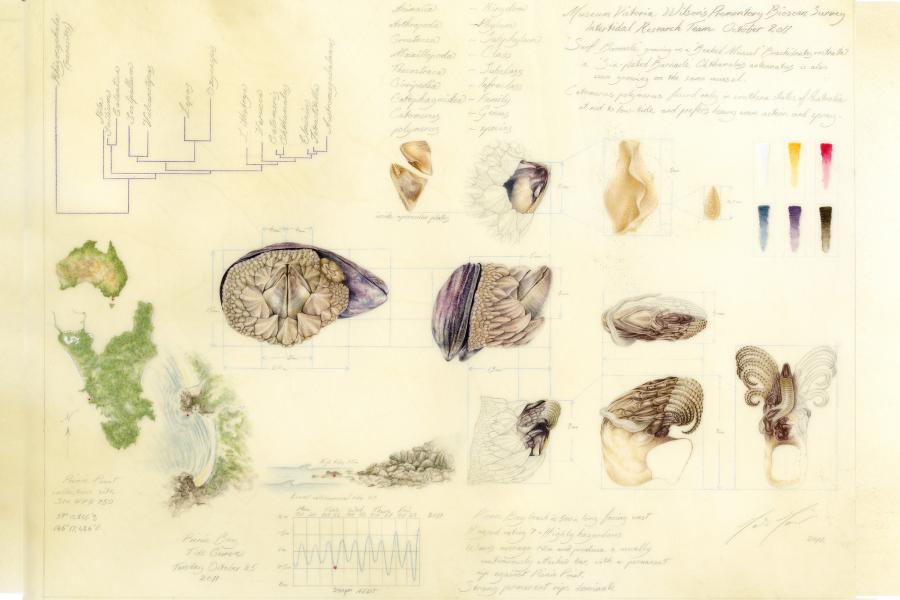Barnacle, ‘Dragon Barnacle’, 2013, Mali Moir

Species: Surf Barnacle, Catomerus polymerus
Location and habitat: Southern Australian coasts.
Conservation Status: Unknown
Title: 'Dragon Barnacle'
Creator: Mali Moir
Date: 2013
Medium: Pencil and watercolour on natural vellum
Copyright: Used with permission.
At precisely 3:40pm, Australian Eastern time, on the 25th of October 2011, at the bottom of a low tide brought on by the waning crescent moon, the Intertidal Research Team descended upon a particular Surf barnacle and pried it from a particular rock found on the Picnic Bay headland, Wilson's Promontory, Australia. All of this information -- and much more -- is beautifully captured in a series of diagrams and cursive handwriting embedded in this artwork. Coordinates, classification taxonomies, measurement grids, colour pallets, and notes on the expedition, all play out with watercolour pencils on vellum (treated animal skin), combining to give an old fashioned sense of knowledge and beauty in a unified aesthetic.
Perhaps the most compelling component of this image are the illustrations of this particular Surf barnacle. Upon being brought back to the artists studio and put under the microscope, the barnacle was dissected and drawn in exquisite, anatomical detail. Once the dragonic scales are removed, a complex lifeform is revealed, with long grasping appendages that can pull food from passing water into its shell to consume: these creatures are closer to spiders than they are to seashells. This particular species, the Surf barnacle, is easily identifiable by the whorls of small plates that surround it, no other living species of barnacle in the southern hemisphere has this feature. Indeed, this also marks the Surf barnacle as a relic, for this pattern of shells is only otherwise found on ancient fossil barnacles. This is additionally peculiar, as living relics like this are generally found in very isolated habitats, like on deep oceanic hydrothermal vents, not in rich, dynamic and diverse habitats like tidal coasts.
As the artist, Mali Moir, said to me in our correspondence: "I love discovering huge worlds in tiny bodies". Indeed, on that, the Surf barnacle was first scientifically classified by Charles Darwin himself, in -- since we're being specific here -- page 487 of his 1854 book entitled A Monograph of the Sub-class Cirripedia, with Figures of all the Species. The Balanidae (or Sessile Cirripedes); the Verrucidae, etc. This was the third book of four sprawling volumes he produced on the subject of barnacles. Darwin became totally obsessed with dissecting barnacles and mapping out their alien bodies, work he would grind into for extended hours, neglecting his family, and making himself sick and twisted. In a moment of despair, Darwin confided in a friend: "I hate a Barnacle as no man ever did before". Despite the his suffering, it was through the long tedious work of examining barnacles that a key component of his theory of evolution came together, for it was within the subtle differences between barnacles of the same species that he discovered the internal variations that reveal evolution to be a living force active in reshaping the world.
Quotes
No quotes found.
Login to add a quote


